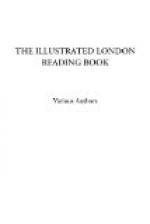Upon quitting this district, the country became far more dreary: it appeared nothing but a dry and sterile region, the soil being remarkably hard and slatey. Here we saw many curious figures, and we soon found that the inhabitants of this desert were mere ciphers. Sometimes they appeared in vast numbers, but only to be again suddenly diminished.
Our road, after this, wound through a rugged and hilly country, which was divided into nine principal parts or districts, each under a different governor; and these again were reduced into endless subdivisions. Some of them we were obliged to decline. It was not a little puzzling to perceive the intricate ramifications of the paths in these parts. Here the natives spoke several dialects, which rendered our intercourse with them very perplexing. However, it must be confessed that every step we set in this country was less fatiguing and more interesting. Our course at first lay all up hill; but when we had proceeded to a certain height, the distant country, which is most richly variegated, opened freely to our view.
I do not mean at present to describe that country, or the different stages by which we advance through its scenery. Suffice it to say, that the journey, though always arduous, has become more and more pleasant every stage; and though, after years of travel and labour, we are still very far from the Temple of Learning, yet we have found on the way more than enough to make us thankful to the kindness of the friends who first set us on the path, and to induce us to go forward courageously and rejoicingly to the end of the journey.
Jane Taylor.
* * * * *
PEKIN.
Pekin, or Peking, a word which in Chinese means “Northern Capital,” has been the chief city of China ever since the Tartars were expelled, and is the residence of the Emperor. The tract of country on which it stands is sandy and barren; but the Grand Canal is well adapted for the purpose of feeding its vast population with the produce of more fertile provinces and districts. A very large portion of the centre of the part of Pekin called the Northern City is occupied by the Emperor with his palaces and gardens, which are of the most beautiful description, and, surrounded by their own wall, form what is called the “Prohibited City.”
[Illustration: Grand canal at the entrance to Pekin.]
The Grand Canal, which runs about five hundred miles, without allowing for windings, across the kingdom of China, is not only the means by which subsistence is brought to the inhabitants of the imperial city, but is of great value in conveying the tribute, a large portion of the revenue being paid in kind. Dr. Davis mentions having observed on it a large junk decorated with a yellow umbrella, and found on enquiry that it had the honour of bearing the “Dragon




